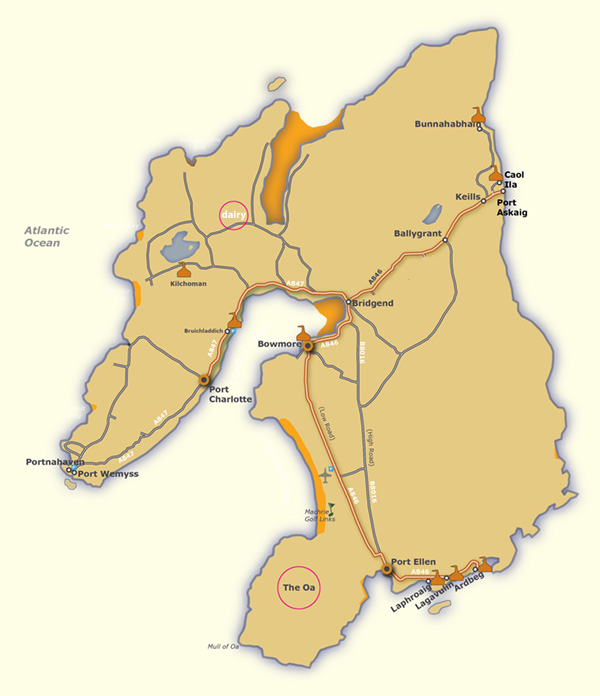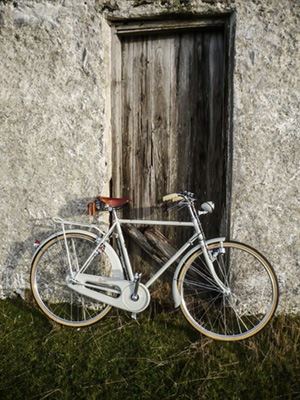
..........................................................................................................................................................................................................
overture and beginners

it's not often that i'm given to prevarication prior to a bike review, but in this instance, i believe a short (who am i kidding?) history and geography lesson may well be in order to set the scene.
i'm guessing that everyone has at least a faint notion of just where islay is situated in relation to the larger part of scotland. not being one much given to gps co-ordinates, allow me to generalise somewhat by pointing out that if you can find glasgow and head west on the same latitude, there we are. the island is almost split in two parts by two sea lochs; loch indaal from the south and loch gruinart from the north. there's a thin strip in the middle featuring raised beaches that keeps east and west conjoined as a single island. on the easterly section, there is a large peninsula featuring dramatic sea cliffs facing the atlantic known by its inexplicably short name: the oa.
between the oa and the rest of the island are two roads leading pretty much in the same direction and more or less to the same destinations. the more contemporary edition, the a846 is eight miles of dead straight roadway, allegedly built along the route of a proposed railway line, one that was cancelled in the light of the beeching cuts of the early 1960s, once the longest stretch of geometrically straight roadway in the highlands (excluding motorways). locally, this is known as the low road.

the older route (perhaps predictably known as the high road), is a single-track road officially designated the b8016 and essentially bypasses the island's principal village of bowmore and aims directly for bridgend. from there onward travel to port askaig in the north, or bruichladdich, port charlotte and portnahaven in the west is easily undertaken. mrs washingmachinepost's grandfather travelled along this road in the 1930s, from his home on the oa to reach his place of work at gruinart dairy, on the shores of that sea loch heading in from the north. this is a distance of around seventeen miles which could be managed by motor car in around 35 to 40 minutes, taking into account the state of the roads and that only around four miles are other than single-track.
however, in the 1930s, only the wealthy owned motor vehicles, few of whom lived on islay. public transport simply didn't exist, so the only options open to mrs washingmachinepost's grandfather were horse or bicycle. economics and location apparently mitigated against the former, so his daily trip was undertaken on a heavy steel roadster with never more than a single gear. the trip to work occupied not only six days of his week in both directions, but had need of getting him there for around 6:30am. all those who currently complain about their daily commute would do well do bear this particular trip in mind.
however, unlike modern times, there was not only little option, but nothing with which to compare it; simply a case of getting on with it.
i've ridden pretty much every single road on the island several hundred times, but more often than not on lightweight carbon fibre with more gears than grandfather donald would have known what to do with. but i've always harboured a desire to retrace his wheeltracks on a similar type of bicycle, just to see what it was like. to this end, malcolm glass of glasgow's pronto gara lent me a taurus corinto, an italian cycle made of lugged steel, with rod-operated stirrup brakes, mudguards, swept back handlebars and a rear rack augmented by a small newspaper rack on the bars. seating is by brooks of england, in the shape of a sprung b66. aside from the sturmey archer three-speed hub gear, there are front and rear lights powered by a tyre-driven dynamo.
in truth, it is the most stately bicycle i have ever ridden; a real pleasure. the review, which will follow in a day or so, and other than a couple of exploratory rides, was carried out by my riding the basis of that daily commute from the oa to gruinart dairy (now derelict). not the usual ride on a bicycle designed for urban use, and a whole lot different than my usual reviews.
cycling and personal transport as it once was. soon...
friday 31 january 2014
 ..........................................................................................................................................................................................................
..........................................................................................................................................................................................................